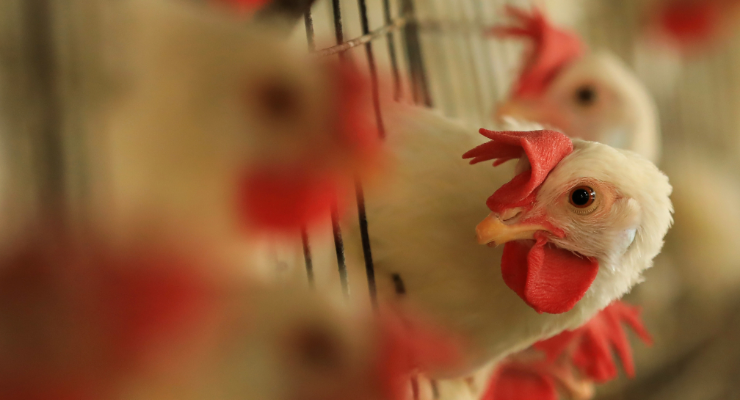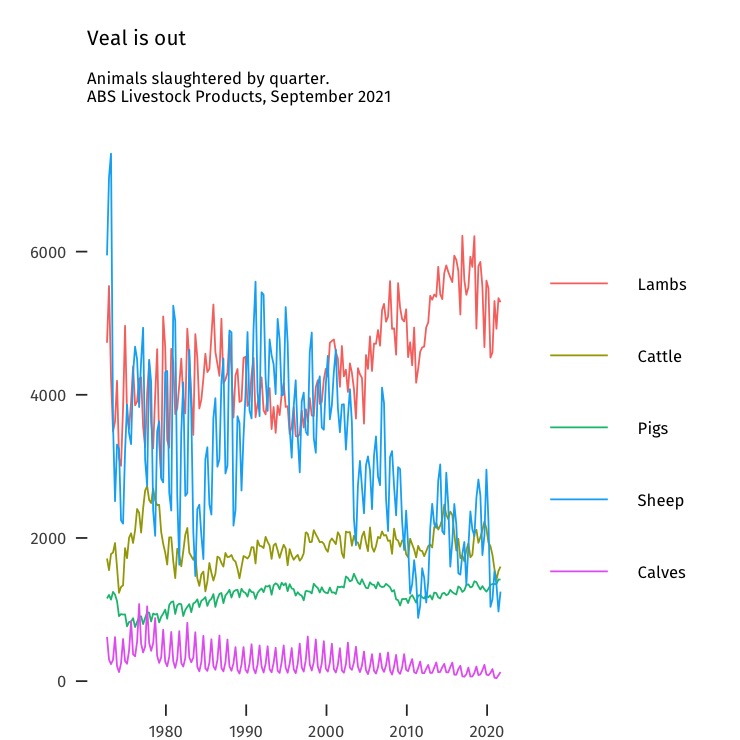
“What the heck am I going to have for dinner?” is what I found myself wondering three days ago as I wandered the aisles of my local Woolworths, surrounded by pristine, unobstructed views of the shelves.
Much of what I wanted was out of stock so I got to have quite a good look at the back wall of the meat fridge — especially where the chicken would usually be.
Even KFC was running low (it cleverly turned it into a PR coup, with stories in all the popular press). It turns out Australians eat a lot of chicken. A crazy amount, in fact.
I went looking for data on just how much chicken we eat, and the story is astonishing. The Australian Bureau of Statistics produces beautiful regular data on meat production and the change over time in chicken consumption is startling.
It’s good news if you like cute mammals. The number of cows sent to the abattoir has not kept up with population growth, as the next chart shows. The number of calves being processed is down hugely. Veal is passé. Lambs are still being eaten, of course, and pigs too.

But our ability to have increasingly protein-heavy diets and a higher population is all thanks to the chickens.

The Omicron blip in chicken production is the first real slowing in our consumption of the white meat in decades.
The extraordinary difference between the popularity of chicken and other meats raises the question: why?
One way of answering that is to look at price inflation of the bird in question. It costs more or less the same as it did in 1990. Up perhaps 10%. As the next graph shows, other meats have risen in price much faster in the same period.

Of course, this leads to further questions such as why is chicken so damn cheap?
Well chicken is cheap to make. Chickens, unlike cows, can be grown in operations that are truly industrial. And that permits us to unleash the full force of industrial innovation on their brief, sorry lives.
Meat chickens in this country are not grown in battery cages, the Australian Chicken Growing Council says, but they are grown in barns where automation and computer monitoring are de rigueur.
This chicken farming video gives you a sense of the scale of it all. It starts with some beautifully cinematic shots of pristine hatcheries and cute fluffy yellow chicks but — due warning — before long turns into something not for the faint of heart.
The Australian industry is dominated by two big players. Inghams, which is listed on the stock exchange, and Baiada Poultry, which is a privately owned family business. They are vertically integrated, meaning they own the whole system — from chicken feed to processing.
“[T]he recent Omicron surge in Australia has presented unprecedented challenges to Ingham’s Australian business, with many Ingham’s employees being forced to isolate at home,” Inghams’ CEO recently told the stock market.
It won’t take long for the industry to get back on track after any blip in production — the life cycle of a meat chicken is as little as five or six weeks. The farmers just need to incubate the eggs and restock the barns and the great growing can begin again.
Beyond the organic segment, which accounts for 1% of the market, chicken farming is not so much about chickens scratching around in the grass. It’s about speed and weight.
Speed allows farmers to produce many chickens a year each barn. A chicken can live for several years, but the ones we grow for meat don’t. The result of that is that the number of chickens eaten each year is far higher than the number of chickens alive at any one point. And every chicken is bigger now. An Australian chicken used to yield 865 grams of meat in 1965. Now it is 1.95 kilograms a bird.
The rising volume of meat from each bird must be good news for the animal lovers among us. At risk of sounding trite, the moral impact of taking a life must be lower when the yield of doing so is higher. What’s more, chickens have tiny brains. I am an ex-vegetarian and once calculated the best animals to eat from a protein-yield to brain-size perspective. Chickens were among the best choices.
Chickens are also much lower in carbon emissions than red meat. Each kilogram of beef produces 10 times the carbon of a kilogram of chicken. Which means the future will not be beefy. Steaks are arguably going the way of the horse and cart — you see them around, but you don’t have them at home.
Unless the lab-grown meat industry starts making some dramatic steps, the incredible rise of the humble chook looks set to continue.








Chickens are utilitarian – there are few religious objections, and they’re not cute. Rabbits are faster to deliver protein, but can never be halal or kosher.
True, although I’d forgotten about the religious prescriptions! As an occasionally lapsing vegan I tend to think along the lines of Peter Singer – read 20 years ago so wary of my paraphrasing and simplification, but essentially judging on complexity of nervous system, social order and self awareness. So chickens are lower than mammals, but above fish. Things like dolphins and primates are right out. Pigs usually put above sheep / cows. Then again, I’ve had chickens and got quite attached them, and worked with sheep which I think are remarkably stupid. I”ve never realy thought in terms of “one cow is about 225 chickens”. Until now…
These days, my primary concern is environmental, so that’s a bit rough on the fouls as the article mentions.
Since Peter Singer’s original work, a lot has been found out about how smart some birds are. Corvids and parrots especially, but very likely chooks as well. Anyway, they can (and do) certainly suffer.
You omitted the human alter ego, the goat.
Look into those slitted eyes, esp an old Nanny and be agape.
Oh, I always separate the sheep from the goats
There is a sound reason for Mark 25:31-46.
Sheep can be driven, goats must be led hence the preference, by priest & politician, for sheep.
Goat sense terrifies them.
Why not? Is it the Easter bunny thing?
Leviticus 11:3-6.
Don’t, by careless association, sully Astarte’s name.
It’s ok. Chickens don’t have souls.
Neither do humans, but that’s beside the point.
Wasn’t it Joh who referred to the press sc(r)um as ‘feeding the chooks‘?
It often surprises people how quickly chooks can learn to fly, given the opportunity (to practice) when the occasion strikes.
(As Sir Arfur Streebling-Greives observed of his life long obsession, “ ‘E doan so moush floyie as plummette…”
So many of our social mores are predicated on an easy familiarity with the staples of rural life – which has been declining against urbanised cannon/commercializm fodder since late 20thC.
Aww. The only thing that challenges my godlessness is knowing a I have a soul.
So glad I’m a vegetarian.
And how come the chickens are now heavier? What do they have to pump into them to make then that way?
Because they don’t walk much, let alone scrape & scrabbling in soil and weeds.
Oh, and steroids, hormones & antibiotics – but everyone knows that.
Not true. The reason why you can buy a cooked chook from the supermarket for $10 is because the whole operation is run so tightly. The growing sheds are huge with set safe population density. Plenty of room. Also, Dead chickens don’t pay. The sheds are monitored weekly by RSPCA and it was my job to swab the floors weekly. The feed stock didn’t have any “oids” because they don’t need them and all those additives cost money. It’s all in the breeding and breed. Growing cost per chicken is measured to 1 hundredth of a cent.
I worked at a chicken hatchery and delivered the day old chickens to the farms with sheds. That video didn’t show the ugly bits. I did hatchery Take Off which is transferring the DOCs from Hatcher trays to delivery trays. Firstly, after 150 years of breeding, the brood stock, the Roosters and Hens, are huge. Because secondly, what we eat are 35 to 50 day old chicks coming in between 1.3 and 3 kg depending on contract weight.
Didn’t some US Prez (Hoover) once promise “40 acres & a mule in every pot!” as a definition of basic security?
Or was that Henry IV?
40 acres and a mules was what freed slaves were meant to get or something (I get my US history from Public Enemy songs). A chicken in every pot was some French king, wasn’t it?
Interesting those sort of statements. They were really just early Morrisons – a grand announcement that never got delivered (and probably was never intended to be delivered).
Interesting, but one grumble – the scale for animal production is thousands of beasts, you left that off. 175,000 chooks per quarter would be slim pickings for over 20 million people.
The local operation here can do 250,000 chickens per week for a regional population about the same.
Sounds as if they are sufficiently interchangeable that the chooks should be given the vote – they could not do worse in selecting an M.
It is no surprise to learn that you’re proud to claim to work in a Belsen house.
Peeps is weird.
How appalling.